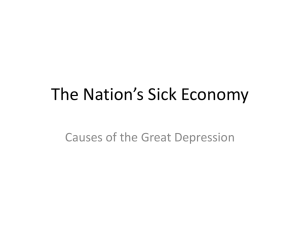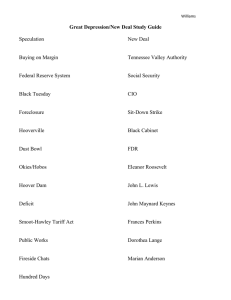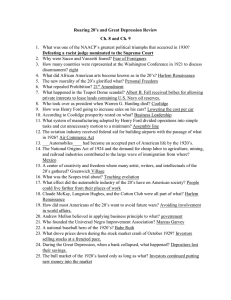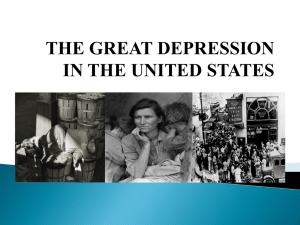cause of the Great Depression
advertisement
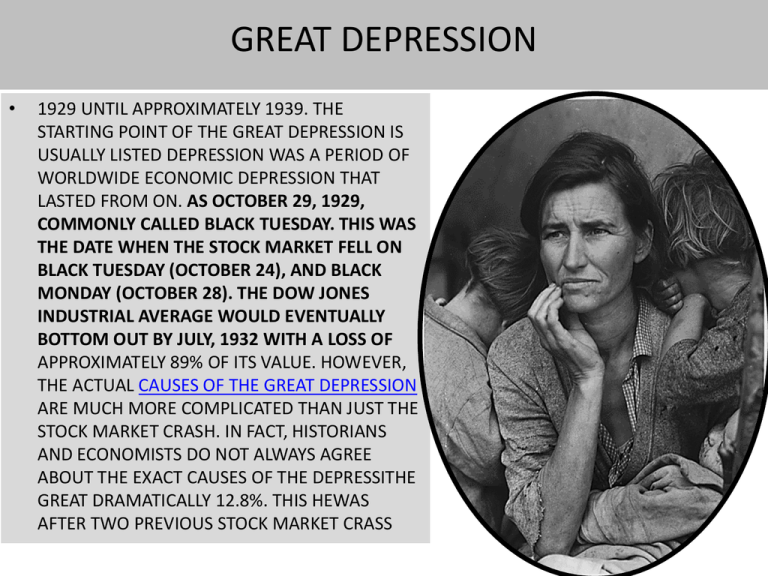
GREAT DEPRESSION • 1929 UNTIL APPROXIMATELY 1939. THE STARTING POINT OF THE GREAT DEPRESSION IS USUALLY LISTED DEPRESSION WAS A PERIOD OF WORLDWIDE ECONOMIC DEPRESSION THAT LASTED FROM ON. AS OCTOBER 29, 1929, COMMONLY CALLED BLACK TUESDAY. THIS WAS THE DATE WHEN THE STOCK MARKET FELL ON BLACK TUESDAY (OCTOBER 24), AND BLACK MONDAY (OCTOBER 28). THE DOW JONES INDUSTRIAL AVERAGE WOULD EVENTUALLY BOTTOM OUT BY JULY, 1932 WITH A LOSS OF APPROXIMATELY 89% OF ITS VALUE. HOWEVER, THE ACTUAL CAUSES OF THE GREAT DEPRESSION ARE MUCH MORE COMPLICATED THAN JUST THE STOCK MARKET CRASH. IN FACT, HISTORIANS AND ECONOMISTS DO NOT ALWAYS AGREE ABOUT THE EXACT CAUSES OF THE DEPRESSITHE GREAT DRAMATICALLY 12.8%. THIS HEWAS AFTER TWO PREVIOUS STOCK MARKET CRASS 1. STOCK MARKET CRASH OF 1929 Many believe erroneously that the stock market crash that occurred on Black Tuesday, October 29, 1929 is one and the same with the Great Depression. In fact, it was one of the major causes that led to the Great Depression. Two months after the original crash in October, stockholders had lost more than $40 billion dollars. Even though the stock market began to regain some of its losses, by the end of 1930, it just was not enough and America truly entered what is called the Great Depression. 2. BANK FAILURES Throughout the 1930s over 9,000 banks failed. Bank deposits were uninsured and thus as banks failed people simply lost their savings. Surviving banks, unsure of the economic situation and concerned for their own survival, stopped being as willing to create new loans. This exacerbated the situation leading to less and less expenditures 3. REDUCTION IN PURCHASING ACROSS THE BOARD • With the stock market crash and the fears of further economic woes, individuals from all classes stopped purchasing items. This then led to a reduction in the number of items produced and thus a reduction in the workforce. As people lost their jobs, they were unable to keep up with paying for items they had bought through installment plans and their items were repossessed. More and more inventory began to accumulate. The unemployment rate rose above 25% which meant, of course, even less spending to help alleviate the economic situation. AMERICAN ECONOMIC POLICY WITH EUROPE • As businesses began failing, the government created the Smoot-Hawley Tariff in 1930 to help protect American companies. This charged a high tax for imports thereby leading to less trade between America and foreign countries along with some economic retaliation. 4.SMOOT-HAWLEY TARIFF The Smoot-Hawley Tariff Act of June 1930 raised US tariffs to historically high levels. This piece of legislation was originally intended to help protect domestic farmers against agricultural imports. During World War I, countries outside of Europe increased their agricultural production. Then when the war ended, European producers stepped up their production. Thus massive agricultural overproduction occurred during the 1920s. This in turn led to declining farm prices during the second half of the decade. One of Herbert Hoover's campaign pledges during the 1928 election campaign was to aid the American farmer and others by raising tariff levels on agricultural products. 5. DROUGHT CONDITIONS • While not a direct cause of the Great Depression, the drought that occurred in the Mississippi Valley in 1930 was of such proportions that many could not even pay their taxes or other debts and had to sell their farms for no profit to themselves. This was the topic of John Steinbeck's The Grapes of Wrath. GREAT DEPRESSION VIDEO Causes-of-the-Great-Depression.htm GREAT-DEPRESSION-FLASH-CARDS WALK THE PLANK
